Pier, Tar, and Tepees
Comment via blog
Prev
Next


|
Day 17: August 12, 2014 Pier, Tar, and Tepees Comment via blog |
Prev Next |
 
|
|
|
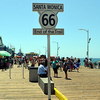
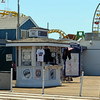
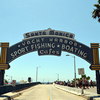
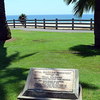 OK. So the title of this trip claims a connection with Historic Route 66
but so far it hasn't touched the road. Today that changes... a little...
kinda. In the past, I've always been careful to visit and photograph a true
US-66 terminus. Either the original at Seventh & Broadway or the later
one at Olympic & Lincoln. Since I didn't reach Los Angeles on
Sixty-Six, that seemed less important today and, in fact, today seemed
like a good time to take in a couple of other spots often associated with the western
end of the historic highway. The first is the Will
Rogers Highway plaque on Ocean Boulevard where Santa Monica Boulevard
ends. Route 66 was also called the Will Rogers Highway. The Santa Monica
Pier is definitely a place many people associate with the end of Route 66
and, in recent years, a specific business on the pier has been the end
point of many a trip. That business is 66-to-Cali whose owner, Dan Rice, has been active in
Route 66 promotion. He was instrumental in getting the "End of the
Trail" sign erected a little further out on the pier. That sign is a replica
of a movie prop that stood nearby for many years.
OK. So the title of this trip claims a connection with Historic Route 66
but so far it hasn't touched the road. Today that changes... a little...
kinda. In the past, I've always been careful to visit and photograph a true
US-66 terminus. Either the original at Seventh & Broadway or the later
one at Olympic & Lincoln. Since I didn't reach Los Angeles on
Sixty-Six, that seemed less important today and, in fact, today seemed
like a good time to take in a couple of other spots often associated with the western
end of the historic highway. The first is the Will
Rogers Highway plaque on Ocean Boulevard where Santa Monica Boulevard
ends. Route 66 was also called the Will Rogers Highway. The Santa Monica
Pier is definitely a place many people associate with the end of Route 66
and, in recent years, a specific business on the pier has been the end
point of many a trip. That business is 66-to-Cali whose owner, Dan Rice, has been active in
Route 66 promotion. He was instrumental in getting the "End of the
Trail" sign erected a little further out on the pier. That sign is a replica
of a movie prop that stood nearby for many years.
These locations have been called sentimental, or popular, or traditional. There is something attractive about ending a trip at water's edge. Maybe that's sentimental. As for tradition, the Will Rogers plaque surely qualifies. It has been there longer (62 years, 1952-2014) than the actual route existed (59 years, 1926-1985). |
|
|
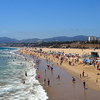
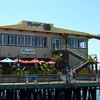
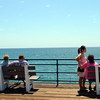

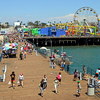 Of course I looked over some of the bathers as I walked the length of the
pier. Then I enjoyed a cool Mexican beverage in the Mexican restaurant at
pier's end and, from the top level of the building, tried to see what he
saw before heading back to shore.
Of course I looked over some of the bathers as I walked the length of the
pier. Then I enjoyed a cool Mexican beverage in the Mexican restaurant at
pier's end and, from the top level of the building, tried to see what he
saw before heading back to shore.
|
|
|
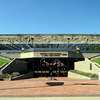 My next stop was at the La Brea Tar Pits just a few miles away. The museum now
offers a free "Excavator Tour" which I wanted to take advantage
of. When I left the motel, I was thinking of going directly to the museum
and taking the 12:30 or even the 11:30 tour. Then, for some reason, I
decided to go to the pier first and target the 2:30 tour. By the time I
left the pier, I was hoping to make the 3:30 tour. I asked about the tour
as I bought my museum ticket and learned it was just leaving. As the
attendant handed me my ticket, he pointed out the tour group and I quickly
caught up with them.
My next stop was at the La Brea Tar Pits just a few miles away. The museum now
offers a free "Excavator Tour" which I wanted to take advantage
of. When I left the motel, I was thinking of going directly to the museum
and taking the 12:30 or even the 11:30 tour. Then, for some reason, I
decided to go to the pier first and target the 2:30 tour. By the time I
left the pier, I was hoping to make the 3:30 tour. I asked about the tour
as I bought my museum ticket and learned it was just leaving. As the
attendant handed me my ticket, he pointed out the tour group and I quickly
caught up with them.
|
|
|
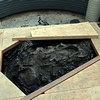
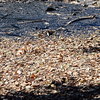
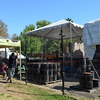
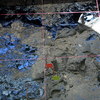
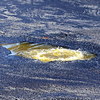
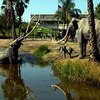 Serious and organized excavation of the tar pits started in 1913 and
continues today. More than a million bones have so far been extracted from
the pits where animals died after becoming entrapped in the sticky tar.
Although the mass of tar and bones in the first picture is a
reconstruction, it was cast from actual bones and is an accurate view of
what was originally found in the pits. It's housed in what was the
first museum here. Outside, real pits can be
seen behind fences.
Serious and organized excavation of the tar pits started in 1913 and
continues today. More than a million bones have so far been extracted from
the pits where animals died after becoming entrapped in the sticky tar.
Although the mass of tar and bones in the first picture is a
reconstruction, it was cast from actual bones and is an accurate view of
what was originally found in the pits. It's housed in what was the
first museum here. Outside, real pits can be
seen behind fences.
In 2006, nearby construction of a parking garage encountered a lot more fossils than anticipated. In order to save the fossils and allow construction to continue, wooden boxes were built around them and the boxes hoisted out and moved here. Project 23 takes its name from the number of those boxes. Behind the fence, the work of extracting and documenting the contents of the boxes goes on seven days a week. The fourth picture shows Pit 91 where excavation has continued, with lots of big gaps, since 1915. This is the count of the bigger finds. Underground pressure continues to bubble through the water and tar as seen in the fifth picture. |
|
|
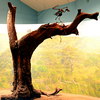
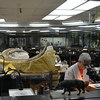
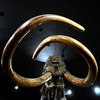
 Page Museum has plenty of fossils from big creatures like camels and
mastodons but the small stuff is there, too. The worker in the third
picture is using a microscope to find tiny fossils of both plants and
animals. During the outside tour, the guide asked if anyone knew what was
the largest fossil ever found at La Brea. After hearing guesses of mammoths
and mastodons, she explained that is was sort of a trick question since
the largest fossil was of a tree. This is it. A 14,500 year old Juniper
that was found upright, indicating that the tar and earth rose to encase
it, four feet underground.
Page Museum has plenty of fossils from big creatures like camels and
mastodons but the small stuff is there, too. The worker in the third
picture is using a microscope to find tiny fossils of both plants and
animals. During the outside tour, the guide asked if anyone knew what was
the largest fossil ever found at La Brea. After hearing guesses of mammoths
and mastodons, she explained that is was sort of a trick question since
the largest fossil was of a tree. This is it. A 14,500 year old Juniper
that was found upright, indicating that the tar and earth rose to encase
it, four feet underground.
|
|
|
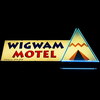
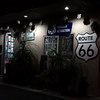
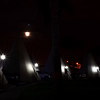 I'd timed things terribly so that I caught LA rush hour leaving the
museum. A wreck that closed two lanes of I-10 added to the fun. But it
could have been worse and I made the fifty-some mile drive to San
Bernardino in a little over three hours. My
room at Wigwam
Village #7 was ready and waiting and I got some pictures of the
lighted sign in the darkness that arrived soon after I did.
I'd timed things terribly so that I caught LA rush hour leaving the
museum. A wreck that closed two lanes of I-10 added to the fun. But it
could have been worse and I made the fifty-some mile drive to San
Bernardino in a little over three hours. My
room at Wigwam
Village #7 was ready and waiting and I got some pictures of the
lighted sign in the darkness that arrived soon after I did.
|
|
|
| [Prev] [Site Home] [Trip Home] [Contact] [Next] |